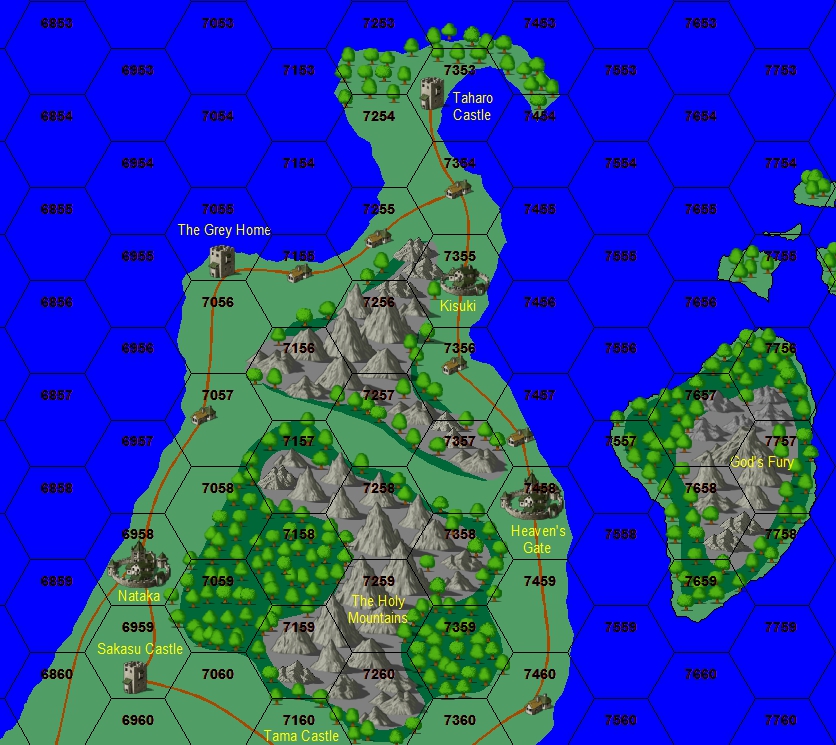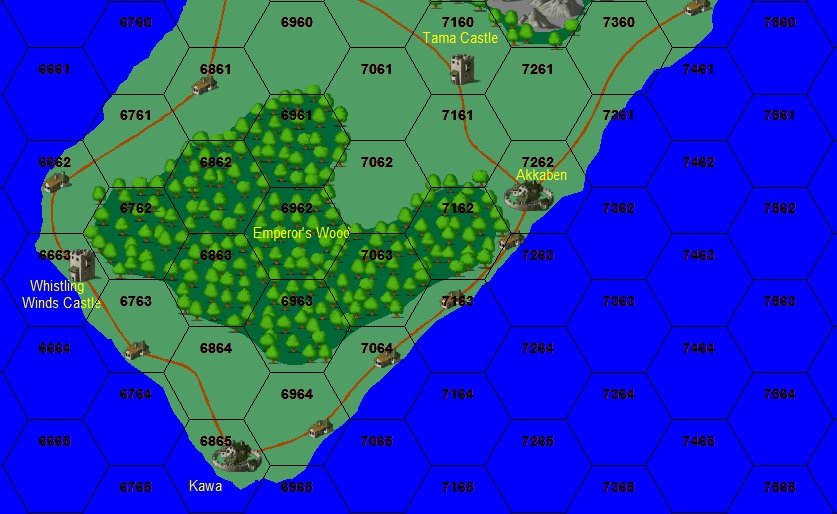Tang Empire
 | |
|---|---|
| Founded | early FA |
| Size | Major Kingdom |
| Ruler | Emperor Kaji of the South Wind |
About the Tang Empire
The Tang Empire includes the largest island in the Realm and a number of small islands in an archipelago in the southern waters of the Great Sea. Warm currents keep the northern parts of the Empire in a temperate climate, although the southern half of the main island is famous for frigid, howling winds and icy conditions in winter.
The population of the Tang Empire is almost entirely ratfolk. The ratfolk are counted as the best sailors in the Realm, and the Tang Empire galleys can be found in ports throughout the world. The traders of the Tang Empire are well trusted, and most of the Realm's sea trade happens under their jurisdiction. Few ratfolk are found in the nations outside the Tang Empire - with no major known communities. In fact, while ratfolk may visit for a few months or even a year at a port of call, they always return to the island after a short while.
Around 900 TA, the first appearance of a powerful drug, a hallucinogen which gives the user tremendous strength in exchange for brief periods of insanity, began showing up in ports around the Realm. Given the nickname "warpstone dust", the origins of the drug appear to coincide with the arrival of Win Lu, Grandmaster of Chaos. In some areas, the use of warpstone dust has created pockets of instability and insurrection with local rule. The drug is forbidden by law in most ports, making it the most highly prized black market commodity.
Organization of the Tang Empire
The Tang Empire has long been shrouded in secrecy, although its roots go back to the very beginning of time. For as long as history has been recorded in the ancient stone scriptoriums of Sarth, there has been an unbroken line of Tang Emperors – whose power is absolute.
The Emperor Shiba (852-905 TA)
Ruling from 852-905 TA, the Emperor Shiba was the last of the line of rulers under the guidance of the Grandmaster of Law.
Although his last five years were guided by Win Lu, Grandmaster of Chaos, the Emperor Shiba reluctantly embraced change to the millennium-old lawful traditions of the Tang. It is rumored that his last years were also influenced by Valdemar, deposed ruler of Sandal. In 900 TA, he declared the Code of Honor and Law broken and ordered the first of a number of unsuccessful invasions of the Reaches releasing the Runebound Warriors to execute the Great Summoning of the Forbidden.
In October 905 TA, after devastating losses to the Reaches in the first invasion of the Tang homeland in centuries, the Emperor Shiba and several advisers - including his son Prince Oda and Koto, First Admiral of the Fleet - were found dead at the emperor's retreat in the Holy Mountains.
The Emperor Kaji (905-present TA)
In November 905 TA, a new Emperor - Kaji of the South Wind - assumed the throne at the palace in the walled city of Heaven's Gate. A middle-aged ratman of unimpeachable lineage, Kaji has already proclaimed peace with the Reaches and a resumption of free trade with all ports of call. In a break from his predecessor who deemed them unlawful, Kaji has also opened up dialog with the pirates of Tormod Bay and the dark elves of Dor Daedeloth. Some believe this is the influence of Win Lu, Grandmaster of Chaos.
Kanpaku
The wisdom - and some say the power - of the Emperor is found in his ten advisers: the kanpaku. Each of these advisers holds dominion over one important facet of Tang life. The Grandmaster of Shipwrights, for instance, oversees advances and changes to the powerful Tang Armada. The kanpaku are chosen from a number cloistered shrines scattered throughout the islands of the empire. Of the kanpaku, the most enigmatic was the Grandmaster of Law - the oldest living ratman having emerged from the the Tenth Shrine in the late Second Age until his disappearance in 889 TA. While serving, the Grandmaster of Law could be found at the Emperor's side for all critical decisions of state.
In June 899 TA, the most mystical shrine, the Tenth Shrine, opened for the first time in a thousand years. From it, emerged a single figure - Win Lu, the Grandmaster of Chaos.
The Great Houses
In addition to the kanpaku, the appointment of important positions within the Tang Empire are drawn from the eldest sons and daughters of the four Great Houses. It is said that all Tang are descended from four brothers and four sisters who came down from the Holy Mountains early in the First Age to settle the island. Many marriages between the Houses has created a twisted lineage, although the leaders of each House claim a direct line from the Eight. While there is much political intrigue in the courts of the Tang Empire, no open warfare between the Houses has occurred since the Second Age.
The four Great Houses are associated with the winds - an all-important element for a race of sailors. House Kisuki is the North Wind. House Nataka is the West Wind. House Akkaben is the East Wind. And, House Kawa is the South Wind. Emporer Kaji comes from the House Kawa. Although he has abandoned his family ties in order to become Emperor, his title still bears the moniker "of the South Wind".
Northern Tang Empire
| ||||||||||||||||||
Southern Tang Empire
| ||||||||||||
History of the Tang Empire
It is clear that ratfolk society was established early in the First Age, as written records tracing the lineage of the Tang emperors can be found dating from that time. Confined on a small island with limited natural resources, the Tang were quickly forced to learn how to build ships and sail. At first, these early sailors focused mostly on fishing which provided the staple of their diet. As their skills increased, the Tang ventured further into the sea in search of larger fish and whales. Eventually, the Tang made contact with the outside world, first encountering the elves in the present-day Wilderlands. Documents from the Elven Histories of the First Age tell of this meeting. By the end of the First Age, the sight of Tang sailing ships was common in most of the harbors of the Realm. This tradition has continued throughout the Second and Third Ages.
Little is actually known of the Tang homeland, as visitors are not welcome on the island. The Tang are ruled by a hereditary Emperor, and there seems to be little discord about his rule. He is rumored to sit upon a ruby throne in a palace made of solid gold. There, he has a crystal ball which allows him to watch for the safety of all the Tang ships in all the oceans of the Realm.
In the middle of the Third Age, Tang traders began a tradition of carrying one human merchant on all of their galleys. This master merchant is responsible for negotiating with the humans of the Realm. It is said that these merchants are allowed to disembark on the island, and some have been rumored to have met the Emperor. These rumors have never been verified.
The Tang remain politically neutral and seem just as comfortable dealing with pirates as kings. There are no significant exports from the Tang Empire, as the ratfolk typically act as warehousers and ferriers in most exchanges.
Interesting Places Nearby
Huhueteotl Islands
Little is known of the Huhueteotl Islands, except that it is inhabited by tribes of cannibal savages - purportedly descended uncivilized since the Second Age. Expeditions have sometimes retuned with considerable wealth and tales of mines where gems abound. A massive, ancient tree is reportedly the gathering place for the savage tribes when they ready for warfare and raiding. Contact has been through various merchants of the Tang Empire.

